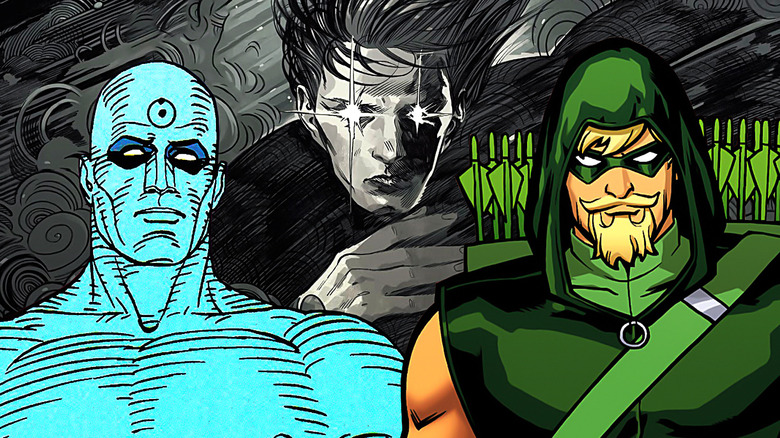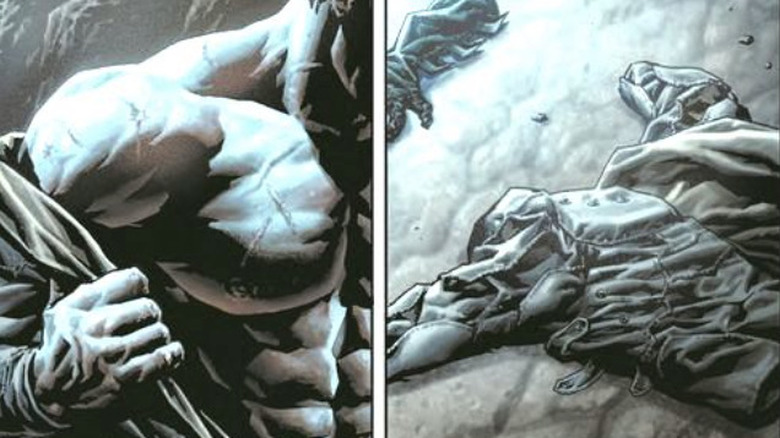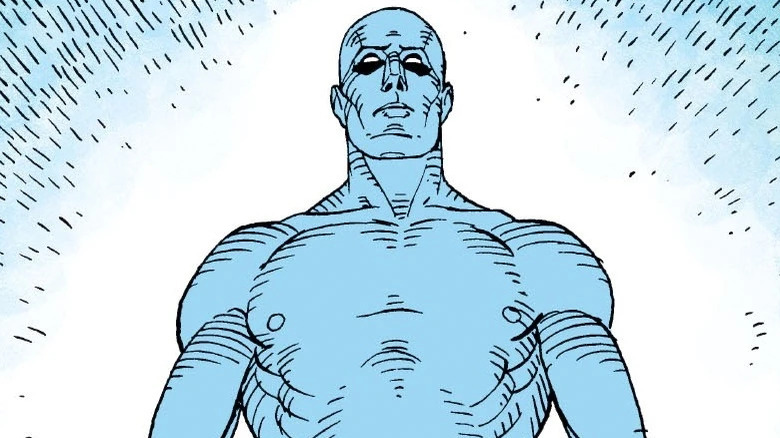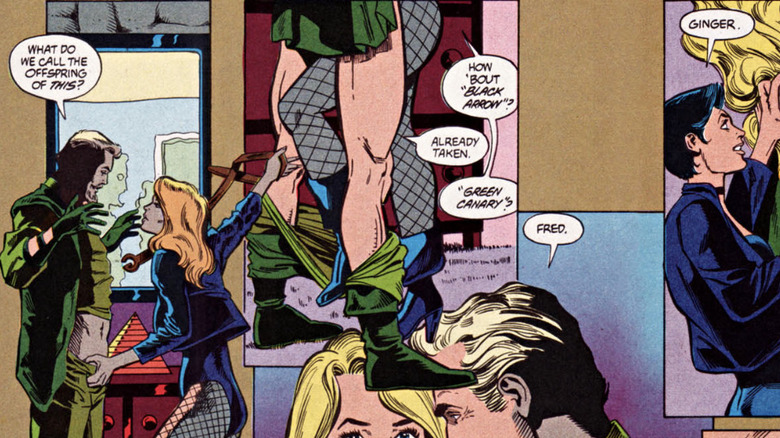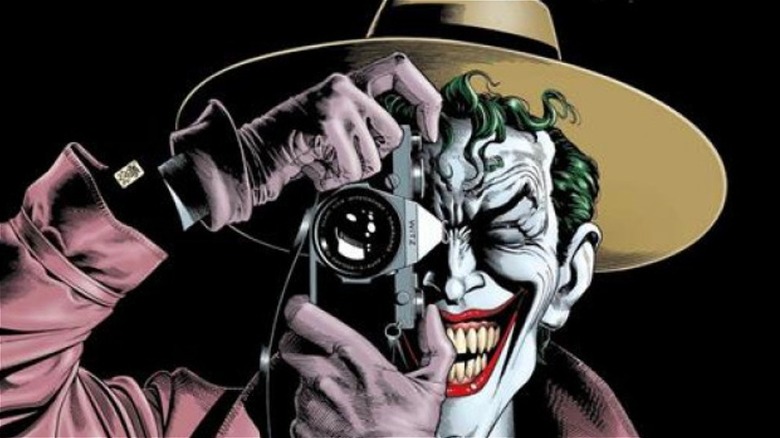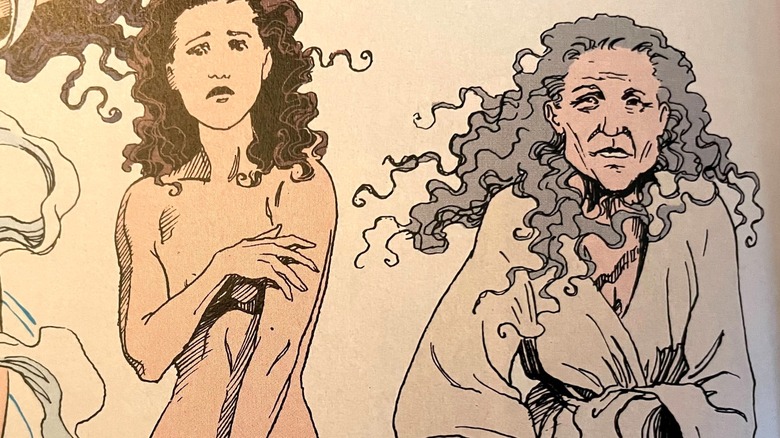5 Controversial Times DC Comics Got Away With Super Hero Nudity
Comic books tell stories involving all types of genres, heroes, and adventures. However, despite the medium generally being used to spin tales fit for all ages, a handful of comics have intentionally (or unintentionally) offered more adult stories and/or pushed the boundaries when it comes to what's appropriate for readers — especially when it comes to showing nudity.
The reasons for a comic to feature unclothed characters vary, but generally involve some aspects of the following: to humanize larger-than-life characters, to add some spicy content to stories, and to shock readers. In the pages of DC Comics, artistic nudity is seen in adult-oriented comics such as "Sandman" and "Hellblazer." Other examples range from sex scenes showcasing fan-favorite superheroes such as Black Canary and Green Arrow to the controversial use of full-frontal nudity in a Batman comic that made international headlines. While there are many examples of comics showcasing the un-costumed bodies of DC's most iconic characters, these five are among the most interesting and infamous.
DC got a major headache after publishing the Bat-Wang
When DC Comics first launched its Black Label imprint, an adult-oriented line of comics generally intended to not be bogged down by past continuity, it arrived with controversy. In the original printing of "Batman: Damned" #1 (by Brian Azzarello, Lee Bermejo, and Jared K. Fletcher), Bruce Wayne is seen out of costume in the Batcave, where his penis is shown in a scene featuring full-frontal nudity. Dubbed the "Bat-Wang" issue, more than a hundred thousand copies of the comic made their way to the public before DC censored the image in future printings as well as retroactively hiding it in its digital release.
Ultimately, the nudity wasn't added for a specific storytelling reason but rather to simply include a risqué moment. Former DC co-publisher Dan DiDio also claimed production errors related to coloring made the nudity a bigger deal than intended. "I think we made some choices after it went out," DiDio said at New York Comic Con, "and there were some production errors that led to the book being published the way it was ... that ended up being a big story. But thankfully, people were very pleased with the story and the content, the beautiful art, and the story."
Instead of becoming a tone-setting book for the Black Label line's high quality, "Batman: Damned" made headlines for showing Batman's private parts, with major news organizations and late-night talk shows, including "Late Night with Seth Meyers," making cracks about the nudity. As a result, the book led to DC Comics becoming more strict concerning what would be released under the Black Label moniker to appease higher-ups and avoid controversy.
Doctor Manhattan's nudity is iconic
One of the most famous examples of nudity in comics comes from the critically acclaimed classic "Watchmen" (by Alan Moore, Dave Gibbons, and John Higgins). In the DC Comics tale, the omnipotent Doctor Manhattan is often seen fully nude with his genitals on display. The character losing the few clothes he wore as the story unfolds is not about titillation but to reflect how he becomes less connected to humanity and its concerns about social norms as he evolves.
In an interview with Sequential Tart, Gibbons explained that the portrayal of Doctor Manhattan being nude was very intentional, comparing it subtly to classic sculptures. "We were very careful about the way we introduced the nudity, though; it didn't happen in the bedroom scene but while the good Doctor was alone in the desert. I was careful to give him understated genitals, like a piece of classical sculpture, too. I'm sure some people didn't even notice he WAS nude for a page or two and by then, it was too late!"
Basically, Moore and Gibbons convinced DC Comics to allow the full frontal nudity of a male character by making sure it was done as tastefully as possible. Since then, the character's naked nature has remained a vital part of his character. It has been adapted in sequel "Watchmen" stories, including DC's "Doomsday Clock" and HBO's "Watchmen" — the latter of which involved a plotline that saw Doctor Manhattan's penis inspire a sex toy for Laurie Blake, aka his former girlfriend, Silk Spectre.
DC published a nude scene in Green Arrow
One of DC's most iconic couples, Green Arrow and Black Canary, have shared many intimate moments over the years, but in "Green Arrow" #34 (by Mike Grell, Dan Jurgens, Frank McLaughlin, Julia Lacquement, and John Costanza), the story showed much more than a simple kiss.
The comic opens with Oliver Queen and Dinah Lance talking about baby names. After arriving home, Dinah shows Oliver his costume, telling him that seeing him wear the ensemble always turned her on. Queen agrees to wear his superhero outfit if she sports her iconic fishnets and blonde wig. The pair subsequently have sex while joking about the baby they're going to make. The scene turns NSFW as a naked Black Canary's entire backside is exposed. Things get even more graphic when a subsequent panel shows Oliver on top of Dinah, with readers able to see one of her nipples and breasts.
The sex scene ends when Oliver is forced to cut the encounter short and suit up as Green Arrow. He tells Dinah he loves her, and she encourages him as he goes out into the night with his bow and quiver. The comic remains spicy, implying that Dinah takes care of herself after he leaves. If you're wondering how DC Comics allowed so much sexual content in the pages of one of its most popular superhero's stories, the cover for the series regularly warned about its adult material with a warning, "suggested for mature readers."
Batman: The Killing Joke was originally much darker
"Batman: The Killing Joke" (by Alan Moore, Brian Bolland, John Higgins, and Richard Starkings) is one of the most influential and important DC Comics stories ever published. It showcases how the Joker became the Clown Prince of Crime while featuring one of the most intense encounters between Batman and the supervillain ever put to print.
But despite its acclaim, "The Killing Joke" has long been criticized for its use of sexual violence in the story, specifically regarding the treatment of Barbara Gordon, aka Batgirl. The comic implies that the Joker sexually assaulted Barbara after paralyzing her. As shocking as this is, the controversial scene that features Barbara naked, wounded, and frightened was almost much more graphic.
Decades after "Batman: The Killing Joke" was released, the original artwork for the dark encounter between the Joker and an injured Barbara made its way online. Bolland's art shows her fully nude while crying, with her breasts visible on the uncolored page. Bolland confirmed in a blog post after his original art went live that he "drew what was in the script. That's my job. I was asked to tone it down a bit." Considering how traumatic the published scene was, DC appears to have made the right call by toning down the sexual violence. It's hard to imagine how the comic and scene would be received if it were even more graphic, as it already felt like Moore and Bolland were pushing boundaries that were already somewhat questionable.
DC's Vertigo was filled with nudity
DC's former adult-oriented Vertigo imprint didn't shy away from featuring nudity, as some of its most popular titles often featured characters wearing little to no clothes.
For example, in "Sandman" #40 (by Neil Gaiman, Jill Thompson, Vince Locke, Daniel Vozzo, and Todd Klein), the story of Adam's Three Wives is told, with the art showing a fully nude Lillith, a barely covered-up Nameless One, and a fully clothed Eve. Meanwhile, Lucifer Morningstar can be seen naked in the comic, although the sexless character doesn't have a penis despite presenting as male. Several other Vertigo titles also feature tasteful nudity, including the "Lucifer" spin-off series, the John Constantine-starring "Hellblazer," and the misfit team-up comic "Doom Patrol."
Vertigo stories often explore the mature, bizarre, and otherworldly, so the nudity within the comics rarely feels tacked on to make things sexier. Instead, it's used to show a human side to several larger-than-life characters or, on the flip side, the grotesque and hedonistic nature of others. Among the many comics featuring nudity, DC's Vertigo titles regularly offered the most artistic interpretations of what could otherwise be considered schlocky or shoehorned in.
